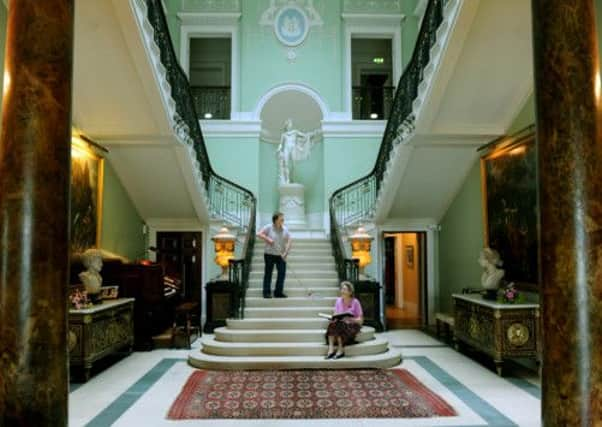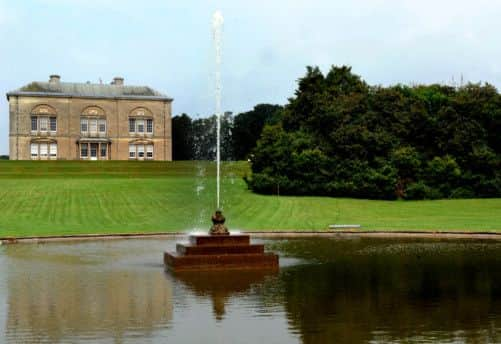The family estate: How to run a stately home


IT’S no surprise to hear that when she goes home Cynthia Walker likes to put her feet up while her husband does the cleaning.
You’d be the same, if your job involved overseeing the cleaning of 45 rooms including 15 bedrooms and 11 bathrooms, not to mention 2,071 window panes that must be buffed to a crystalline sparkle once a month.
Advertisement
Hide AdAdvertisement
Hide AdThen there’s the silver and brass, the countless rugs, pieces of porcelain, precious items of furniture, statuary and antique book collection, scores of picture frames, the organ, banisters, and parquet and marble floors. The bill for cleaning stuffs must be enormous, and all of this work is done by four part-timers.


By the time the House opens to the public the 14 rooms they can visit must be in tip-top shape. If Sledmere House’s owner, Sir Tatton Sykes, has friends staying for a house party or shoot, then Cynthia’s team will have the added workload of dusting, tidying and vacuuming bedrooms and bathrooms and replacing sheets and towels every day.
But still, after 23 years, she loves her job. “It is like a military operation, and the room I find most difficult to clean is the Music Room,” says Cynthia. It feels like a large and well-appointed living room with family photographs, drinks trolley, a coffee table piled with books and an antique desk strewn with the current incumbent’s letters and pens, seemingly abandoned mid-sentence.
In among the artefacts bought by the family’s successive generations of wealthy merchants are the present Sir Tatton’s collection of ceramic pigs. They’re not necessarily valuable – he “just has a thing about pigs”, say the staff.
Advertisement
Hide AdAdvertisement
Hide Ad“The Music Room and Sir Tatton’s private sitting room are quite cluttered because he uses them regularly, as he does most of the rooms seen by visitors. This afternoon he may well be in there reading and writing. But he’s not that tidy.”
Cynthia’s complaint has an indulgent, affectionate tone to it, as though talking about the mess made by a much-loved child. The nub of what she’s saying is that, for all it is at the centre of East Yorkshire’s greatest country estate – 9,000 acres, of which the majority is farmed by tenants – this lovely Georgian house, which was destroyed by fire in 1911 and rebuilt during the First World War, has a certain friendly informality about it that is refreshing to behold.
There is a remarkable lack of signage, and you can explore the rooms in any order you choose. On Wednesdays and Sundays a guest organist tickles the keys of the House’s famous JJ Binns pipe organ for a couple of hours while appreciative listeners sit back (one or two slipping into a lovely doze) on squishy sofas in the great entrance hall.
There also seems to be a family atmosphere among the staff at Sledmere, where several generations of locals have worked around the house or estate and more than a few have married each other.
Advertisement
Hide AdAdvertisement
Hide AdIt seems that pitching in wherever help is needed at the admission desk, in the shop and around the Terrace Café is a given, whatever your designated job. And there are job opportunities – events co-ordinator Lisa Bradley started out as a schoolgirl waitress in the café.
Lindsey Karavics, who co-manages the café, is married to Andrew the head gardener and they live in a cottage just beyond the car park.
While maintaining the lush formal gardens and parkland as well as some cottage gardens and the village green in Sledmere, Andrew is putting his mark on the estate with new ideas such as the amazing “potager” vegetable garden he established a couple of years ago which has the shape and mathematical precision of an ornate formal parterre but consists of a kaleidoscopic jungle of mostly edible components. The effect pricks all of the senses.
The house and gardens usually attract 20,000- 25,000 visitors a year and at the busiest time, Jenny Mullinger, who works in the café, bakes 50 cakes, hundreds of scones and umpteen buns a week to help cater to the throng. Not buying in helps to keep local people in jobs, and those cakes look and taste (in a very good way) like your granny made them.
Advertisement
Hide AdAdvertisement
Hide AdSummer events – those run by Sledmere itself and others run by outside organisations who simply rent grounds and facilities – include the Caravan Club National Rally, the MG Rally, Sealed Knot battle re-enactments, and the Tribfest camping extravaganza and can bring in 6-7,000.
The estate’s famous three-day Christmas Fair can attract up to 15,000. The house and estate’s 25 full-time and 25 part-time staff cope with all eventualities, doing the extra hours when needed. Although closed for most of the winter, pre-booked groups may still visit the house for tours and private events including weddings are held all year round.
Sledmere Village (all but two houses) belongs to the Estate, and many a new baby is baptised in the church built by a previous Sir Tatton. It all sounds sort of medieval but then Sledmere is a blissful place whose charm lies in being in some ways forgotten by the march of time.
The Estate, on the edge of the Yorkshire Wolds, is six miles from Driffield and 17 miles from Bridlington. The 200 villagers are serviced by only one bus a week to Driffield.
Advertisement
Hide AdAdvertisement
Hide AdThe Estate as it presently exists was established by Sir Christopher Sykes after the land was originally bought by wealthy Hull merchant Mark Kirkby in 1721.
Sykes was a pioneer of agriculture in the Yorkshire Wolds, which, at the time of his succession, were described as a ‘barren waste’.
From 1771 he applied himself to building farms, barns and cultivating and planting shelter belts that included 54,000 larch trees. He extended and decorated the original manor house and later generations added their own particular quirks and eccentricities, such as the Turkish Room and Roman Catholic chapel, as well as fine works of art collected on their travels.
The Horse Room documents many of the horses bred at the Sledmere Stud in the 19th and 20th-centuries which went on to win Classic races. The stud is still in operation but is no longer owned by the Estate.
Advertisement
Hide AdAdvertisement
Hide AdAmazingly, when the 1911 blaze started and burned for 18 hours at Sledmere, it started far up enough in the rafters to allow all of the house’s treasures to be removed including doors and staircases and the plans, drawings and paintings of the original house which meant it could be reproduced by building work that continued throughout the First World War. Samuel Wyatt and Christopher Sykes’s vision rose up again in stone, and Joseph Rose’s intricate plasterwork was copied, then the Hepplewhite, Chippendale and Sheraton furniture restored to its rightful place.
For Stephen Greenfield, land agent at Sledmere, its unique selling point is its nationally renowned picture postcard quality. He says it attracts the interest of film and TV companies regularly – and the income from use as a location would be welcome – but so far many have visited yet none have gone ahead with a shoot. “It may that, beautiful though the estate and house are, we are just a bit too far from London or big hotels. We live in hope, though.”
As with every stately home and other visitor attractions, last summer’s shocking weather took a great toll, and visitor numbers plunged by 40 per cent – the worst since the Foot and Mouth outbreak. The 2011 season had been tough, too, due to a combination of recession and hikes in the price of petrol.
One strategy for addressing the dip was to introduce the Gold Card Scheme, whereby for £2 extra on your first visit (basic adult admission to house and gardens is £8.50) you receive a card giving free membership for the rest of the season. This has bumped up numbers considerably, and Greenfield reports that the business is covering its costs with visitors above average so far this year.
Advertisement
Hide AdAdvertisement
Hide Ad“As I’m sure everyone is doing, we are looking for ways of cutting costs and of holding events at minimal cost that get people through the gate – such as Open Farm Sunday, which brought in 700.
“We’ve also had our first Family Fun Bike Ride, which attracted 100 cyclists to do a trail around the parkland of either two or four miles. We struggle to intercept people travelling to or from Hull or York and need to tap into the kinds of activities people want, the sort of thing that capitalises on our beautiful landscape while being safer than cycling on the road in many places.”
“Our finances are helped by EU subsidies for agriculture, but we also need the area to gain profile as a holiday destination, and designation as an area of outstanding natural beauty would help.”
History lovers get a bonus at Sledmere with a small museum devoted to the Wagoners’ Special Reserve, established by Sir Mark Sykes, sixth baronet.
Advertisement
Hide AdAdvertisement
Hide AdThe brave men commemorated here were not only wagoners from the Wolds farms, but carters, blacksmiths and saddlers, and they were among the first to go to France in World War 1, driving the horse-drawn supply wagons for the troops.
What does the present owner Sir Tatton Sykes, see as future challenges for his home and estate? “I believe our main challenges at Sledmere are threefold: first it must remain commercially successful to ensure it continues as an entity and as one of the main economic drivers in the area.
“Secondly, it needs to continue to fulfil its social responsibilities in the local community and wider society by providing homes, jobs and opportunities for recreation; and thirdly, we need to protect and enhance our wonderful built and natural environment, which makes Sledmere such a special place.
“Sledmere seems to hold a special place in many people’s affections, with a great sense of belonging; I would like to think this will remain so. If Sledmere continues to be well known for its hospitality, beautifully maintained landscape and, in some respects, a refuge from the ‘modern’ world I will be very happy.”
Advertisement
Hide AdAdvertisement
Hide AdLet the last word go to Christine Clappinson, chief steward at Sledmere House, where she has worked for 26 years.
“I love being asked questions by visitors, whether they’re about Sir Tatton’s pigs or why the chains on the chandeliers are covered in cloth. I spend a week’s holiday a year visiting other stately homes, and many don’t feel like living homes, but this does – because it is. It’s so friendly.”